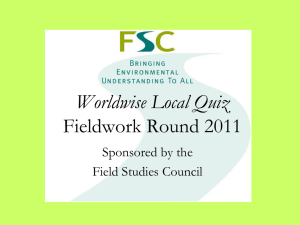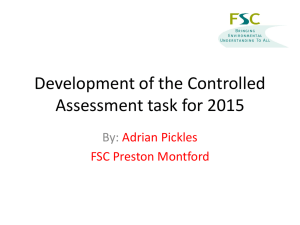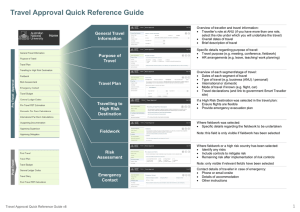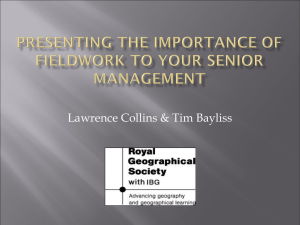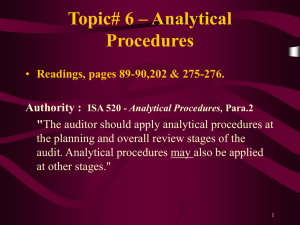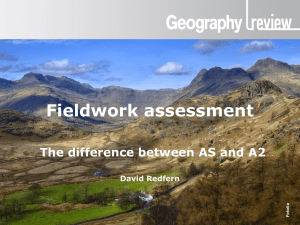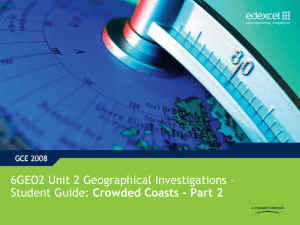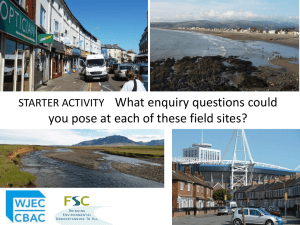Unit 2 - Geographical Investigations - Student Guide
advertisement
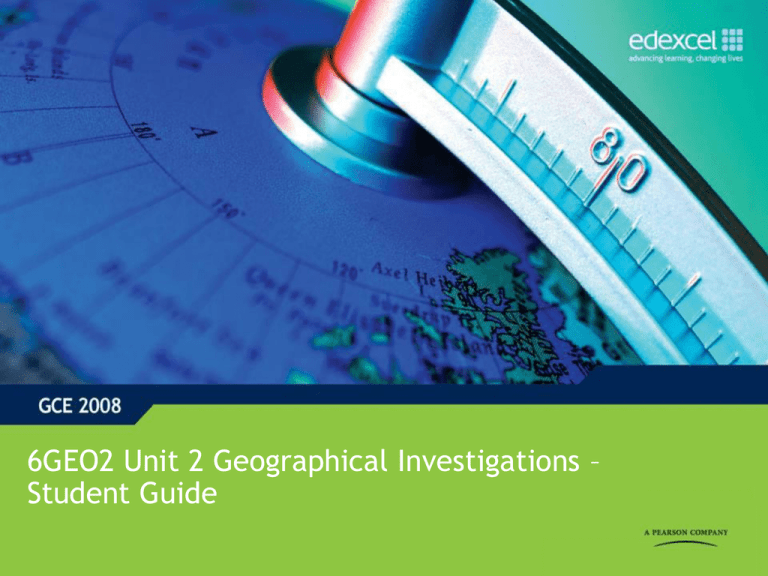
6GEO2 Unit 2 Geographical Investigations – Student Guide CONTENTS 1. 2. 3. 4. 5. 6. 7. Overview Assessment overview + timings Fieldwork audit Handling data stimulus Fieldwork ‘virtuous circle’ Fieldwork rigour + mistakes Moving up the mark scheme Click on the information icon Click on the home button to jump to that section. to return to this contents page 1. Overview • Unit 2 has four components, but you are only required to study two of these. • In the 75 minute exam you answer one question based on your two chosen topic areas. This means there is no choice. • This exam is designed to test both knowledge and understanding of geographical concepts as well as geographical skills. • Fieldwork, research and the enquiry process lie at the heart of this exam. • The most important ways of ensuring the highest possible grades in this module is (i) being able to focus on the question set, (ii) to be able to use resources effectively, and (iii) to get your fieldwork in a form that works for the exam. UNIT 2: The Paired Options –you only study one in each pair! The ‘Physical’ Pair 1. Extreme Weather 2. Crowded Coasts The ‘Human’ Pair 1. Unequal Spaces 2. Rebranding UNIT 2 – Assessment overview and structure • Normally the first part of each question starts with a data stimulus element. • The fieldwork and research elements are related directly to work you have carried out during a field trip AND may involve questions about how you processed, interpreted etc what you found. • The remaining question is more management and issues based. Here case study knowledge will be required. •The data stimulus in unlikely to be the 15 mark question •Data stimulus with an analysis element is possible Time Management • • • • • Sticking to the suggested timings on the exam paper is crucial to success. The paper has 75 minutes in total, so you need to spend about 35 minutes on each question. These leave a few minutes for final checking The 15 mark fieldwork and research questions need the most time as they carry the highest tariff and are time for thinking as you will have to organise thoughts for a specific question focus. The data response and case study style questions should be quicker to do and therefore need less time. Think about quality not quantity. Section a (Resource: 10 marks) ~ 8-10 mins Section b (Fieldwork + Research: 15 marks) ~17-18 mins Managing time on each question: Section c (Case study: 10 marks) ~ 8-10 mins LEAVE A COUPLE OF MINUTES FOR A FINAL READTHROUGH AND CHECK Practice parts of questions under timed conditions. There is no need to fill up all the space on the exam paper Writing a short glossary as you go will be invaluable for final revision A special note on the ‘Fieldwork and Research’ questions (15 marks) • ‘Realism’ and locational detail are likely to score highly. • Questions might be based on: planning & methods, or presentation & results, or conclusions & evaluation • Credit given for reference to: – GIS – new technology + virtual fieldwork – named web references – qualitative and ‘unusual’ methods / sources. EXAMS SKILLS SET • Accurate reference to examples and real places visited is a way of giving realism • Fieldwork and research balance in all areas • Direct use of own work • Awareness of limitations • Use of methods terminology , presentation, analysis etc. Fieldwork Audit – look at the range of areas of the specification that questions can be drawn from. This ‘audit’ covers the main areas to consider. Handling Data Stimulus questions • Expect relatively simple resources - wide range possible including: • Maps / charts • Graphs • Simple tables of data • Photographs / images • Cartoons EXAMS SKILLS SET •Careful observation of the resource •Understand ‘describe’ vs ‘comment on’ •Standing back: looking for patterns, trends and anomalies •Direct use of resource in answer •Full coverage •Use of terminology The part (a) questions are essentially about responding to the resources which have been provided. Rehearsing how to respond to photographs, data and maps is really important prior to taking the exam (e.g. by using these resources as starters at the beginning of lessons), allowing you to deal with patterns, trends and anomalies. It is also very important that you establish whether the task is one of description or explanation. It is certainly not a place to deliver detailed or wide-ranging case studies. ‘Handling’ the photo Typically questions which use an image may start with: 1. ‘describe.....’, 2. ‘describe how’, 3. or ‘comment on’ Your answer needs to take account of these different command words as the response requires a different balance in terms of using the resource and your own knowledge and understanding. It is important to create points of reference, e.g. foreground background, upper left quadrant etc. Do a sketch in your response to illustrate this. A tightly focused response Try to go for a balanced range of ideas. Keep the writing ‘free of fluff’ ‘Virtuous circle’ – this is the idea that the fieldwork and research process needs to be ‘closed’. This means fully written-up in a way suitable for the exam once the field day has been completed. This should be a shared group activity to cover the work more quickly. What are the options for follow-up? A range of fieldwork follow-up options may be appropriate in order to better prepare for the exam. The most important activities are in the light green boxes ACTIVITY 1 – METHODOLOGY WRITE-UP. Give a focus on the techniques and approaches used, how the sites were selected, justification etc. Remember to include both fieldwork and research ideas. ACTIVITY 2 – PRESENTATION and ANALYSIS. Give a focus on the range of techniques used to present the data and say why you used them. Also include a description of how and why data was analysed (including qualitative, e.g. Annotation of photographs etc). ACTIVITY 3 – RESULTS, CONCLUSIONS and EVALUATION. Give a focus on what you found, including some locational detail. You should also give details of selected results, and provide an evaluative framework, e.g. limitations, reliability of results etc. Peer review of other modeled exam responses. Use highlighting, annotation etc to learn from other peoples work. This could be linked to a mark scheme, A fieldwork glossary...very useful to help with technical language in the exam. This could be linked to a techniques matrix (see next slide). A GIS / Google Earth map showing the locations visited as place marks. Mock exam questions completed under timed conditions , linked to each of the three activities above. A PowerPoint presentation , to focus on giving a ‘virtual tour’ of the locations / and or findings. Extract from a techniques matrix Adapted from Unit 2 Guide – Philip Allan Updates Customise and adapt this generic list to hit your fieldwork and research This can be a useful way of reviewing and revising the topic of study. Sharpens terminology and fieldwork range. Fieldwork rigour • It is important to remember Unit 2 is trying to assess skills, as well as application of knowledge and understanding. • Correct use of language, as well as reference to sampling may be appropriate (sample type and sample size). • Discuss how sites were chosen; consider the suitability of different presentation and analytical tools (means and medians etc). • Make sure that any conclusions drawn relate to the original aims of what you were trying to study. Geography Review, GeoFile and GeoFactsheets may all be relevant Research in the exam – important to mention • There are lots of that you can use…but get to together a hot picks list (quote URL / organisation in exam) • List of local sources, e.g. Newspaper, Local Authority, Wildlife Trusts, blogs / forums etc. • Other publications Common mistakes and pitfalls with Unit 2 Pitfalls and failures •Time management issues – running short on the second question. •Writing too much to fill the white space which is not relevant or off-topic. •Ignoring the Figure (part a Qs), or using it partially or imprecisely . •‘All I know’ case studies in the wrong places i.e. the 15 mark F & R question. •Pre-prepared F&R which is not adapted to the specific question. •Lack of balance, with in relation to a Figure, F&R or example. •Missing a key word in a question e.g. ‘impacts’ or ‘strategies’. •To much detail on one F or R method, and therefore a lack of range. Moving up the Mark scheme..understanding the Q Your own work Fieldwork AND research You need to address this part to access the higher level marks Watch for urban / rural rubric issues Mark schemes....make the leap from L3-L4 Look at past mark schemes and reports to see how it is possible to make the leap from L3 – L4. You need to include details + judgments in our example linked to rebranding

